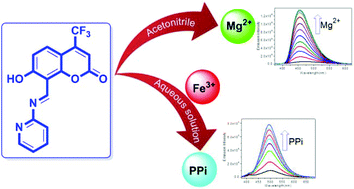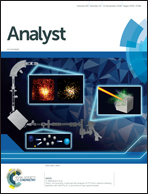Solvent directed selective and sensitive fluorescence detection of target ions using a coumarin–pyridine probe†
Abstract
The development of fluorescent probes to selectively and sensitively detect more than one target analyte under a given condition is a challenging task due to the lack of designing strategies. In this paper, we report the utilisation of the solvatochromic properties of a coumarin–pyridine based probe L1 to detect Mg2+ and PPi, respectively, by using different solvents such as acetonitrile, DMF and DMF–HEPES buffered solutions. When acetonitrile was used as the solvent, L1 was weakly fluorescent and showed a selective and sensitive fluorescence “turn on” response towards Mg2+ with a detection limit of 86 nM, while in DMF and DMF–HEPES buffered solutions, L1 was brightly fluorescent and was able to form a non-fluorescent L1-Fe3+ complex. The obtained L1-Fe3+ complex was further determined to be a selective and sensitive fluorescent “turn on” probe for PPi with a detection limit of 94 nM.



 Please wait while we load your content...
Please wait while we load your content...